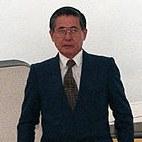Lima (Peru), 1938
By Heraclio Bonilla
President of Peru from 1990 to 2000, is the son of Japanese immigrants who came from Kumamoto, Japan, in 1934. Before entering the 1989 election race with an ambiguous coalition called Cambio 90, Fujimori taught mathematics at the Agrarian University La Molina since 1962, served as dean of the Faculty of Sciences, and was the university’s rector between 1984 and 1989, a position he held simultaneously with the presidency of the General Assembly of Rectors. After graduating in agronomic engineering, he pursued postgraduate studies in physics at the University of Strasbourg, France, in 1967, and in mathematics at the University of Wisconsin, where he earned a master’s degree in 1969.
His handling of the political program Concertando on television confirmed his skills as a manipulator and mediator, developed in university politics. In the final and catastrophic years of the APRA government under Alan García Pérez, the electoral dispute centered on how to address the crisis. The candidacy of Mario Vargas Llosa and the Fredemo (Democratic Front) advocated for full implementation of a deep stabilization policy; Fujimori’s campaign emphasized that this would not be his choice, though he never detailed what he would do. Fear of the negative effects of Fredemo’s policies on Peru’s vulnerable social fabric, combined with Mario Vargas Llosa’s arrogance, explains the rapid rise of the relatively unknown Fujimori, who captured 30.7% of the vote in the first round—a result unpredictable even to the candidate himself. Facing Vargas Llosa’s disinterest in continuing debates and sensing his defeat, Fujimori recruited advisors who quickly assembled an improvised government program overnight.
Contrary to his electoral promises, in the first days of his government, he implemented the “fujishock,” which increased poverty by 70% in a single day. He continued with a stabilization program involving the auctioning of public companies, layoffs, wage freezes, and cuts in public health and education spending. Taking advantage of the discredit of Congress and the Judiciary, as well as corruption, incompetence, and ignorance among their members, he carried out a “self-coup” in 1992, closing both institutions. Faced with mild international pressure, he reopened them with new members, but public opinion found them to be as bad as or worse than before.
With the disappearance of political parties and complete fragmentation of civil society, Fujimori practiced a plebiscitary “democracy,” putting the leader in direct contact with the masses without any mediation; for this, the use and abuse of state resources were essential to guarantee loyalty. Relying solely on the unrestricted support of the Armed Forces, domestic financial and industrial capital, he established an arrogant and arbitrary regime over a population isolated by crisis and dazzled by the defeat of the Shining Path and the Tupac Amaru Revolutionary Movement (MRTA), along with effective inflation control. This context, combined with the complicity of his partner Vladimiro Montesinos and many unscrupulous individuals, explains how theft and human rights violations became government policies.
The crisis and ostracism of Peruvian and Latin American political parties over the last two decades resulted from the contradiction between their public advocacy of democracy and authoritarian party practices, as well as governments’ failures to address people’s problems. Thus, authentic outsiders emerged who, under the pretext of being technicians uncommitted to party machinery, sought voter support by creating ad-hoc coalitions the day before elections that disappeared the day after. Consequently, the candidate-president remained free from accountability for promises made to voters and had no party to oversee his actions.
At the end of 2000, amid a corruption scandal, Fujimori fled to Tokyo, sending his resignation by fax. The Peruvian Congress did not accept it and impeached him in absentia. His dual nationality—Peruvian and Japanese—and the lack of an extradition treaty between the two countries allowed him to escape. In November 2005, during a trip to Chile, he was detained in Santiago, where he remained for six months until extradited and brought to justice in Peru. The trial began in 2007, spanned ninety hearings, and ended in April 2009 when the Special Criminal Tribunal of the Supreme Court found him guilty and sentenced him to 25 years in prison for various crimes, including corruption, formation of a criminal organization, kidnapping, and murder.
In 2015, Fujimori was serving his sentence in a Lima prison and awaited a response to his humanitarian pardon request addressed to President Ollanta Humala. Despite his conviction, the former leader still had thousands of supporters, who helped transform his daughter, Keiko Fujimori of the Alliance for the Future party, into the country’s most voted congresswoman in the 2006 elections. Keiko ran for president in 2011, reached the runoff, and narrowly lost.



